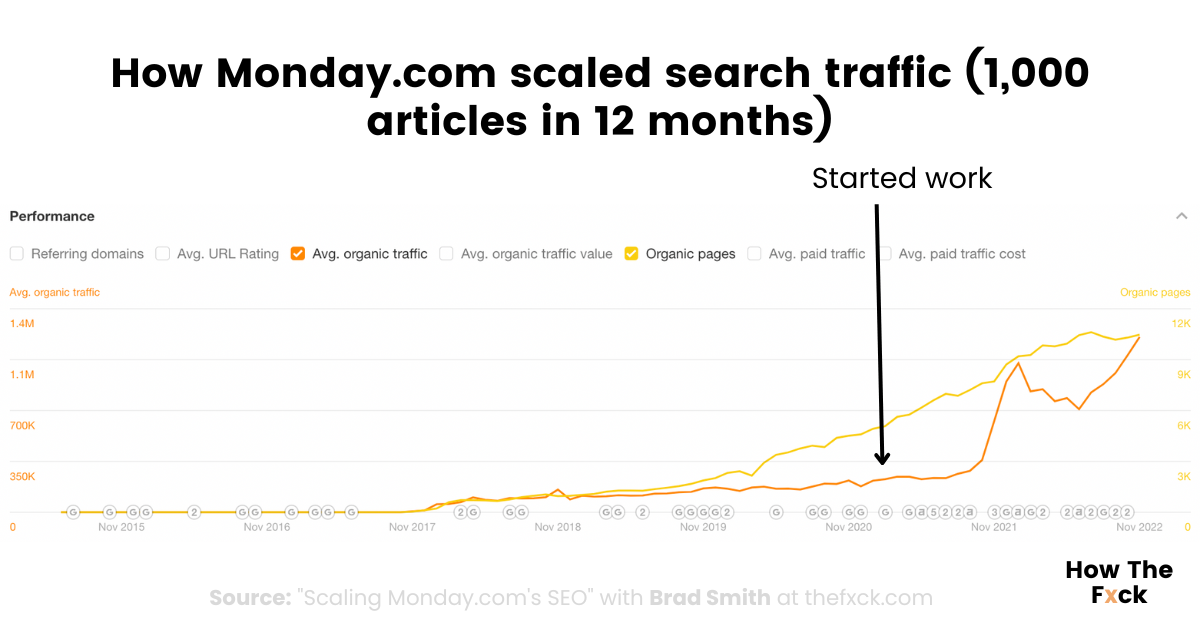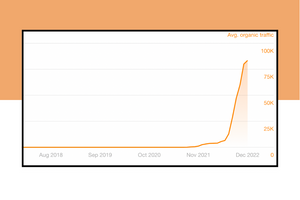Pre-IPO Monday.com dramatically scaled its content production.
I'm talking over 125 new blog posts per month. 1,000 that year.
#moatbuilding paid off.
The traffic growth was stoopid good.
🙌 The headline: 100K to +1.2M monthly organic visitors.
And the story behind the scale is an operational masterpiece.
On the How the F*ck SEO podcast this week, we've got the engineer behind this strategy, Brad Smith, whose team created 1,000 articles for Monday in 12 months.
Brad and his team have mastered content operations and have scaled content for the likes of Robinhood, ActiveCampaign, and FreshWorks, too.

In this week's SEO case study, we deep dive into what it takes to build systems that let you scale the production of quality content.
Expect to learn:
⚡Documentation: What foundational guides are fundamental to scaling content creation? And the ones you must not miss.
⚡Keywords: How to choose those that rank in a short space of time. So you see results now, not in 12 months.
⚡Writer acquisition: How to find enough great writers for 125 articles per month. And filter out the rubbish ones.
⚡Quality: How to write good enough quality for Monday, even on technical topics.
Deep dive into the case study strategy guide by subscribing below.
The Case Study: Scaling Monday.com to 1.2M Traffic in 12 Months
Summary:
Brad worked with Monday.com to scale their organic traffic in the run-up to an IPO. The goal was to heavily invest in brand-building initiatives and new user acquisition to create a defensible moat.
Brad and his team wrote 1,000 articles in 12 months, growing traffic by 1,570% in the first three months and to more than 1,000,000 monthly visitors today.
Challenge:
Our case study focuses on a twofold challenge.
Firstly, what are the content operations that let a small agency create 125 high-quality articles per month? We’ll look at writer acquisition, documentation, and templates.
Secondly, how can you select appropriate keywords and plan for your success? We’ll look at the Planning Predictor Framework™ that Brad’s team uses.
Results:
- 1,570% in the first three months
- 1.2M monthly traffic
- 35,000 position 1-3 keywords
- Top 1 for "Project Management Software" (51K Monthly Searches)
- Top 3 for "Project Management" (300K Monthly Searches)
🕵️ You know the SEO-attributed conversions be wild.
“If you see something working you should continue to pour gas on the fire until you see diminishing returns. That was Monday’s ‘why’ behind investing in content.”—Brad Smith
Background on the content operation
Brad’s team worked closely with the Monday.com team early on to get the right documentation in place.
But, they then mostly took the project off their plate entirely.
👋 All their research, planning, topic identification, keyword research, and content brief creation.
(that's how it should be when you're blitzscaling growth)
That being said, Brad notes in the episode that the Monday team was instrumental in coming up with keyword ideas and prioritizing which keywords to tackle first.
For example, in the beginning, they did a whole month on a project management software keyword.
This one article has 18,000 words on the page, which is a mindblowing amount of content. But now they're position 1 for a high-value conversion page with 50,000 monthly searches. 🤯
To copy this strategy, build efficient processes for the full production process.
For Brad's team, every article had this production process:
- Outline
- Writing
- Editing
- Grammar
- Plagiarism checks
- Design
- Uploading
- Internal links
- Compressing images
Multiple that by 125 a month across 15 writers, and you need crystal clear operations in place (we'll deep dive into documentation later).
The Planning Predictor™ Framework—How Monday.com Chose Keywords
Brad and his team have worked with 100s of companies now. This means they’ve spotted the patterns and have built all the systems needed to de-risk content planning for SEO.
They’ve distilled that into The Planning Predictor™ Framework which helps you decide which keywords to go after for your particular circumstance.
In short, it looks like this.
1/ Harvest Demand
Begin by looking at the different buyer stages for your product and the Jobs-to-be-Done pains and problems you solve.
Back these up into keywords and then expand them to cover the whole topic.
Use: [Customer segment vertical] + [problem or pain point]
Example: [construction] + [project management]
2/ SERP Competitiveness
Even if Ahrefs says Keyword Difficulty (KD) is low, it doesn't mean that keyword is easy to win.
KD is based on backlinks. But, that's not the only ranking factor.
Instead:
1. Enter your keyword into Ahrefs
2. Review the SERP overview
3. Look at the domain ranking (DR) for those in the top 10
If all those sites are a significantly higher authority than your own, it's going to take you 12 months longer than you expect to rank.
Choose keywords where the SERPs themselves are full of low DR sites.
3/ Topical Authority
Monday.com organizes its content into industries. Like this one below on construction project management.
Like all topic clustering, this aids engagement, interlinking, and discoverability.
It also helps you build topical authority, which helps all your content rise faster and higher.
4/ Organic CTR
Unless you’re in the top three search results, you’re unlikely to get much traffic at all.
So you need to assess your likelihood of getting there, your true desire to be there, and your traffic potential once you get there.
If the keyword is high difficulty, with a traffic potential of 200, then even placing third will net you about 30 visitors a month. If the topic isn’t high intent, what’s the point?
5/ Payback Period
SEO has a defined payback period. Some keywords take a lot longer than others for you to rank high for.
You need to ask yourself, can I realistically wait X amount of time for this keyword to rank? If yes, write the content. If no, shift your focus to content updates or areas where you already have topical authority.
The Operations: How to Create 125 Articles Per Month
Brad makes it clear that when scaling content, you cannot rely on one good ninja or marketing rockstar.
You need lots of good people and therefore you need clear, followable systems and processes that are built for scale.
Let's look at the key questions in Brad's operations.
Do you usually build a team specifically around a topic or company?
For a big account, like Monday, Brad builds a team of dedicated account managers, editors, and writers working just for them.
There were 15 writers on this account, which meant they vetted around 1,500 writers to find the best ones.
Because of the complexity of the topic, you should aim to have one writer stay on one topic. That way they can research, learn and improve over time.
Brad notes that it’s a constant battle to bring on new writers and ramp them up to be full-time writers.
How do you find and qualify good writers? (and lots of them quickly)
It’s very hard because what “good writing” is is subjective. It’s not hard to find writers, there are lots of them, the main problem you’ll face is building a strong hiring process.
“The best way I've found to reliably find good writers is just to look at a lot of writers constantly.”
Brad has a six-part process for acquiring new writers at scale:
1/ Run adverts in different places
We’re not just looking for a marketing writer, we’re looking for a SaaS writer with expertise in content strategy. The ads get super specific.
2/ Ask for examples
Request samples and examples from the writer that shows their expertise for marketing SaaS clients. Get very specific with them, and if they can’t give you good published samples, that’s a good way to disqualify lots of applicants upfront.
3/ Disqualify aggressively
Brad asks applicants to format their documents/samples in certain ways during the process. Most people will gloss right over that, which is a great way to disqualify people.
If you’re working asynchronously and at scale, you need people who can follow a style guideline. You need to find writers who can’t follow instructions.
That’s just one example of a check and balance you can put in place to vet new writers. Brad notes, this weeds out 80% of applicants immediately.
4/ Paid writing test
The next step is to pay writers to write a topic. From there you vet whether they can do that well.
5/ Ramp up the writer
Once you’ve found a good writer, you see how much work they can do for you. If they tell you they can do four, start them at two.
It takes a little back and forth to get them up to speed, so start them slow and get them used to the documentation.
6/ Create a buffer
If you’re trying to produce 100 articles for one client, build an internal team that could actually produce 125-150 articles per month.
If people get sick, take a vacation or something goes wrong, you don’t want your content factory to reduce output. Never rely on one individual to keep the lights on.
What about technical topics? Can any writer really write those?
“We assign content topics based on the skill of the writer. If there’s a technical piece, we give it to writers with technical know-how. If it’s narrative driven, a less technical writer can take it. We never throw a writer in the deep end and expect them to win.”—Brad Smith
Brad also recommends having different writing teams for bottom-of-funnel vs top-of-funnel content. Usually, in-house writers are better at doing bottom of funnel because they know the product inside and out.
But in-house writers are slow—they have lots of other stuff on their plate. Freelancers can give you much more output.
Were your writer's people with expert knowledge prior to coming to that topic?
It depends. It’s a bit of both, typically.
What Brad sees is that experts in industries often don’t have the desire (or skill) to write content on the side. It’s not easy to pluck one off the street.
For this project, they found a lot of people who were PMP (project management) certified in the US so they were savvy about project management.
They also found people who had written for topics, like construction, before. They had the vocabulary and knowledge of the space from prior research.
“There's a lot of vocabulary and other things that they need to make the article sound interesting and well written, so you want to look for prior knowledge. However, you also wanna find people that are just good researchers. So it's a slightly different approach where they're less reliant on them being the expert and they're better at going out and pulling in, almost like sourcing a bunch of different ideas and opinions from other people.“
'Research writers' were also able to Monday.com internal experts to get their intangibles, points of view, nuance, and earned secrets. That would help them capture what it’s like to really work in the company.
Editors and Editorial Guidelines
Writers are one important layer. Another is editors. Editors provide that layer of polish and finish and ensure all the writers deliver to the expected standards.
Brad notes that editors that want to totally rewrite every article are a giant red flag for scaling content. He says “It’s the equivalent of not knowing how to delegate.”
The best skill set of an editor is consistency across the board. Sometimes when you promote a writer to editor, they have their own way of doing things, it’s their skillset so they are opinionated.
A good editor is the opposite, consistency is key.
You make your life a lot easier if you spend your time optimizing and operationalizing things for your editors.
Documentation: Making the Subjective, Objective
The problem with scaling content is we need to make the subjective, objective. We need to take what you like and think is good, document it, and train other people on it.
Brad and his team built out one document for each of these:
- Style guide
- Voice and tone
- Resources (what can/can’t they reference and link to externally)
- Terminology (don’t use the word best, instead use X)
- Unique points of view your company has
- Internal link guide
If you don’t do this, then multiple people in the same company give conflicting information or conflicting feedback. “One guy likes it this way and another girl likes it another way.” It’s not feasible.
Your documentation solves this problem. It should be very tangible, concrete, and easy to understand so that quality is not a moving target.
Documentation for Internal Use
Clear documentation for your external teams is important, but so is it for your internal teams.
Give your team clear direction on:
- How to identify keywords on topics
- What types of keywords and topics are we going to prioritize and why
- Editing guidelines to guide editors on exactly what good content should look like.
That keeps them all on the same page and delivering the same quality.
What if You Can’t Explain What Good Looks Like?
As a head of content with high standards myself, I’ve run into this problem with external writers. What if I struggle to put into words the style of writing that I like? How can I make even one person write in the way I’m satisfied with, let alone 15 people?
Brad gave a solution. Instead of saying clearly what you like, point out what you don’t like. He uses a feedback form with the companies he works with. He tells them not to expect perfection the first time, but to invest heavily in feedback in the beginning.
“Don't just tell me you don't like a section or whatever. Highlight specifically what you don't like and why and let's change it.
Cause then, cause that helps you focus on like constructive things. You can improve. And what you wanna avoid is when an editor just rewrite something to make it sound different, but it doesn't actually, The sentence or the phrasing at all.”
If you do things that can’t be documented, you’re going counter to the process of scaling up content production.
Using Templates to Scale
Before you even think about a content brief for an individual article, you should have a template for that type of content.
Are you doing a lot of “what is an X?” definition-type articles, you should create a template for it. Say “here’s where the information comes from, here’s the structure to write.” That helps spoon-feed the writer what you want.
You could build a template for:
- What is X?
- How to improve X?
- How to do X?
- Importance of X?
- X Alternatives
- X vs Y
- X tools and softwares
If you want to create 1,000 articles, that might be only 10 different templates.
What's the Secret Sauce Behind This Success?
Beyond the solid fundamentals we’ve already talked about today (documentation, processes, and systems), I asked Brad what else is the secret sauce for doing this successfully.
His answer? We’re trying to create a franchise like Mcdonald's. It should be scalable—a copiable handbook that anyone can take and do themselves.
You need to consider all the variables and build a living, breathing system that evolves all the time but still has very specific processes for how things should be done.
Then, build a structure to help reinforce it all the time. Get everyone on one page.
The hard part of all of this is the execution. You could have the best documentation in the world but if people don’t follow it, it’s not reinforced, it’s pointless.
“If all this relied on us just being brilliant, that would be bad. I’d probably still be broke.”


